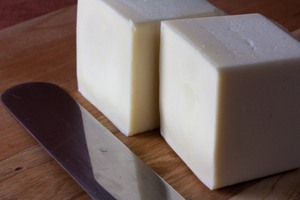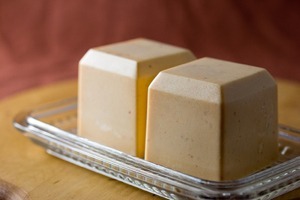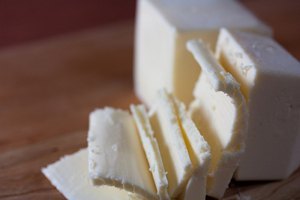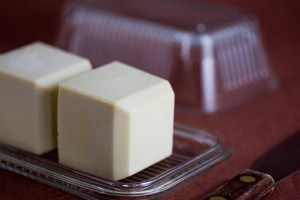White Truffle Vegan Butter
4
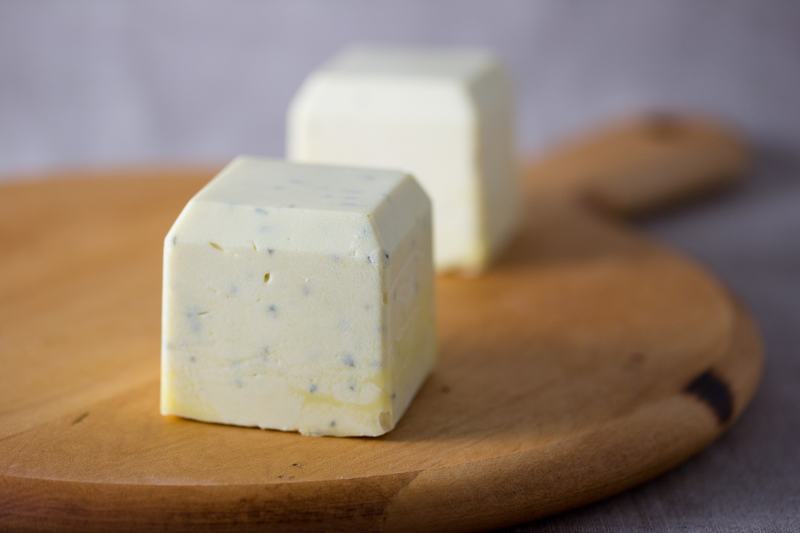
What I like best about Vegan Butter is how it can be crafted to meet your exact flavor and texture specifications. Since we’re building butter from the ground up, we have the freedom to use building blocks that contribute almost any quality we desire. In that roughly 80% fat and 20% water, we have lots of room to play around. For this version I wanted to showcase the unbelievably smooth, savory flavors of truffle oil for a Vegan Butter that could stand up to traditional dairy-based butter as a bread spread, or even quite possibly outdo it when baked into pastry such as savory pie crusts. But why are we infusing vegan butter with truffle oil? Let’s get some background information on what truffle oil brings to the table.
Truffles
Truffles are the fruiting body of a fungus. This fungus grows symbiotically with trees such as oaks, hazels and lindens. Like most mushrooms, the majority of the fungus is underground; it’s only when the fungus needs to spore that it cultivates the necessary energy to produce the fruiting body. Unlike mushrooms, the truffle is a fruiting body that grows underground. It emits an aroma that attracts animals that find it, eat it and spread the spores back into the environment through their excrement. This is why truffle hunters often employ animals to help them unearth their bounty.
Black truffles
Black truffles are known to be subtle and earthy, with a flavor that is thought to be slightly enhanced by cooking. Bonus: it also contains a compound called androstenone that can be found in men’s underarm sweat! Though not everyone can perceive this particular aroma quality.
White truffles
White truffles have a stronger pungent aroma more akin to garlic, which is a result of their more complex sulphur compounds. These truffles are more suitable to be eaten raw. This quality, as well as the more complex, garlicky characteristics, is why I selected white truffle oil to be used in this Vegan Butter.
Truffle oil
Truffle oil is traditionally a vegetable oil such as olive oil that has been infused with the flavor of truffles, usually by immersing a few slices of truffles into the oil. These days, due to the expense of truffles, most truffle oil is made with the use of natural flavors. By this I mean that food scientists have figured out that the majority of truffle flavor is produced by a compound called 2,4-dithiapentane.
This compound creates most of what we know as truffle flavor but there are other compounds that produce or highlight other flavor attributes which differentiate black truffle oil and white truffle oil. I’m unsure of whether other compounds are added to truffle oil to achieve these flavor characteristics, or whether real truffles are used in smaller amounts in these cases.
This natural flavoring conundrum has caused a great deal of controversy in the food world, with many chefs proclaiming that truffles not produced from the real thing don’t belong in the kitchen. At the same time many world class chefs counter that, although real truffle oil is broadly preferred, the artificially flavored version is still a great tool for enhancing flavor as long as you know when and where to use these truffle oils. Combine this controversy with the truffle-oil-mania backlash of the early 2010s and it appears that every chef these days has a strong opinion on it.
The fact is that the unaffiliated palate never really knows whether truffle oil has been produced from real truffles or 2,4-dithiapentane; there’s no regulating body that certifies truffle oil so you can’t really be sure that you’ve ever tasted the real thing or not unless you’ve been lucky enough to eat a real slice of truffle. That brand that the famous chef recommends: maybe they used real truffles in it a few years ago but who knows now? It’s anybody’s guess. This makes it almost impossible for me to recommend a particular brand of truffle oil.
I happen to believe that truffle oil in small amounts is fantastic; as long as special attention is paid to how, when and where it’s used, it can be an extremely useful and fun tool to expand your flavor repertoire in the kitchen. If you agree, then keep reading.
"What?! Are you attemptlng to justify putting chemical flavorings into my food?" Keep in mind that many flavorings such as almond and vanilla often feature their true flavor compounds, but created in a controlled environment instead of in the natural world. I look forward to purchasing real truffle oil the next time I come across it. I'm not concerned that small amounts of the compound that provides true truffle flavor, natural or not, is detrimental to my health. You're free to come to your own conclusion.
"What?! Are you attemptlng to justify putting chemical flavorings into my food?" Keep in mind that many flavorings such as almond and vanilla often feature their true flavor compounds, but created in a controlled environment instead of in the natural world. I look forward to purchasing real truffle oil the next time I come across it. I'm not concerned that small amounts of the compound that provides true truffle flavor, natural or not, is detrimental to my health. You're free to come to your own conclusion.
I found that white truffle oil’s smooth, funky garlic notes were enhanced further by lemon juice as the acid component in this vegan butter. Salt significantly amplifies the savoriness of truffles so I increased it slightly. I then added white pepper and thyme to round out the buttery flavors.
Learn more about the food science behind Vegan Butter.
Learn more about the food science behind Vegan Butter.
White Truffle Vegan Butter Recipe
¼ cup + 2 teaspoons soy milk
1 ½ teaspoons lemon juice
¾ teaspoon salt
½ cup + 2 Tablespoons + 1 teaspoon refined coconut oil, melted
1 Tablespoon white truffle oil
1 teaspoon fresh thyme or ¼ teaspoon dried thyme
1 pinch white pepper
¼ teaspoon xanthan gum or ½ + ⅛ teaspoon psyllium husk powder
1) Curdle the soy milk
Place the soy milk, lemon juice and salt in a small cup and whisk together with a fork. Let it sit for about 10 minutes so the mixture curdles slightly.
2) Blend the fats, thyme and white pepper
Melt the coconut oil in a microwave so it's barely melted and as close to room temperature as possible. Measure it and add it to a food processor along with the white truffle oil, thyme and white pepper. Making smooth vegan butter is dependent on the mixture solidifying as quickly as possible after it's mixed. This is why it's important to make sure your coconut oil is as close to room temperature as possible before you mix it with the rest of the ingredients.
3) Blend the mixture together and place it in a mold to solidify
Add the soy milk mixture, soy lecithin and xanthan gum to the food processor. Process for 2 minutes, scraping down the sides halfway through the duration. Pour the mixture into a mold and place it in the freezer to solidify. An ice cube mold works well. The vegan butter should be ready to use in about an hour. Store it in an airtight container in the refrigerator for up to 1 month or wrapped in plastic wrap in the freezer for up to 1 year. Makes 1 cup (215 grams), or the equivalent of 2 sticks White Truffle Vegan Butter.



